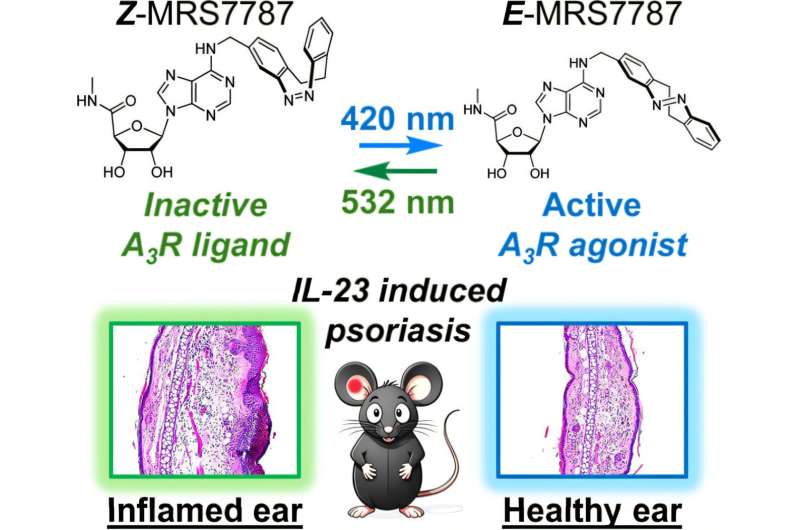When activated by blue light, MRS7787 can modulate the activity of the immune system and treat psoriasis in an animal model, according to a study out of the University of Barcelona.
The study, published in the Journal of the American Chemical Society, characterizes MRS7787, a light-activatable molecule that binds to the A3 adenosine receptor—involved in several intracellular signaling pathways—and generates an anti-inflammatory effect.
The compound MRS7787 has two configurations or two isomers that are rapidly and reversibly switched by light.
“MRS7787 is a photo-switchable molecule. One of the isomers, Z-MRS7787, is inactive, while the E-MRS7787 isomer activates the adenosine receptor,” explains Francisco Ciruela, professor at UB’s Faculty of Medicine and Health Sciences and member of the Institute of Neurosciences (UBNeuro) and the Bellvitge Biomedical Research Institute (IDIBELL), in a news release. “When irradiated with blue light, the molecule changes from the Z to the E configuration, i.e., the active form. However, green light transforms E into Z and inactivates the compound.
“This switching effect is achieved by the covalent binding of a photochrome called diazocine to the A3 adenosine receptor.”
“What’s special about the diazocine photochrome is that it allows the photopharmaceutical MRS7787 to be in its inactive Z-configuration in the dark so that it can be injected without generating any photopharmacological response, and then selectively activated by photoisomerization with blue light,” says and Jordi Hernando, a Professor of Organic Chemistry at Universitat Autònoma de Barcelona, who led the study of the photochemical properties of the MRS7787 compound.
The E-MRS7787 isomer can selectively activate the A3 adenosine receptor without affecting the signaling of the other adenosine receptors. “This activation has an anti-inflammatory effect and reduces the production of pro-inflammatory cytokines by immune system cells. Therefore, activating this receptor is an effective strategy to treat inflammatory processes in general and, in particular, in the approach to psoriasis,” says Marc López-Cano, a postdoctoral scientist at Bellvitge Biomedical Research Institute – IDIBELL in Barcelona.
As part of the study, the animal model was administered the compound MRS7787 and, for eight minutes, a part of the body—namely the ears—where an inflammatory process had been induced was irradiated with an LED device: one ear was irradiated with blue light of 1.18 mW/cm2 intensity, and the other ear with green light of 7.64 mW/cm2 intensity.
The results indicate that the Z-MRS7787 isomer—the result of irradiating the molecule with green light—did not show any anti-psoriatic activity (unlike E-MRS7787), demonstrating that the therapeutic capacity is dependent on the photoswitching of the molecule.
Combining therapies for patients
Corticosteroids, keratolytic agents, calcineurin inhibitors, and vitamin D analogs are some of the most common topical medications used to treat mild psoriasis. More severe cases, where there is widespread skin involvement, are treated with biologics or oral agents.
“Often the latter two treatments can be combined with localized or whole-body phototherapy, which involves exposing the skin to ultraviolet (UV) radiation of broad- or narrowband wavelength. This generalized phototherapy can be complemented by the therapy known as PUVA, which combines an oral treatment with the drug psoralen with UVA irradiation. However, in the long term this has the risk of causing skin cancer,” says López-Cano.
The photopharmaceutical MRS7787 opens new avenues to improve therapeutic efficiency in the multimodal treatment of psoriasis—especially treatment-resistant psoriasis—and to reduce the adverse effects associated with conventional treatments.
“If we combine the compound MRS7787 with PUVA therapy, we could increase treatment efficiency and reduce adverse effects (skin cancer, etc.). The use of multimodal phototherapy could simplify the treatment regimen, as the dosage of light irradiation would be adjusted once a day, the anti-psoriatic efficiency would be maintained and patient engagement with treatment would be improved,” the study authors note.
MRS7787 is a piclidenoson-derived molecule, a non-photosensitive compound that also selectively binds to the A3 adenosine receptor, which is in a phase 3 clinical trial to treat rheumatoid arthritis and psoriasis. The team now also wants to validate this new drug target in other inflammatory conditions—such as arthritis or pain associated with inflammatory processes—to broaden its pharmacological capabilities and enhance its potential interest in other clinical settings.
PHOTO CREDIT: Credit: Journal of the American Chemical Society (2024). DOI: 10.1021/jacs.4c13558


